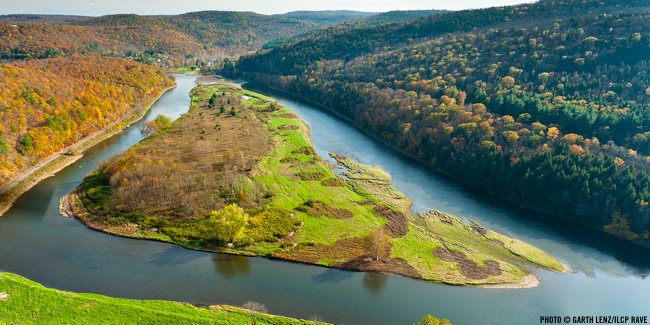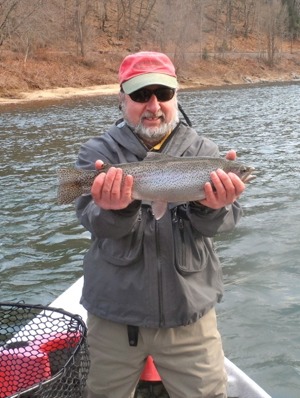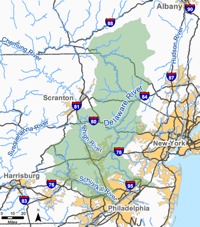As natural gas extraction expands across the Central Appalachian region, that industrial-scale energy development is encroaching on public lands that are critically important for fishing and hunting. In this report, Trout Unlimited takes a deeper look into those public places, outlining the potential risks posed by gas drilling operations and providing recommendations from sportsmen and women that promote responsible energy development.
Upper Delaware River Basin

The Place
Less than two hours from New York City, the Upper Delaware River watershed provides a wealth of hunting, fishing, trapping and other recreational opportunities for anglers and hunters from New York, Pennsylvania and New Jersey. A federally-designated Wild and Scenic River, the Upper Delaware is one of the best places to fish for wild trout in the East. The insect hatches are prolific and the fish are plenty. As a result, each spring, trout anglers from across the nation flock to this arduous river to test their technical skills on what can be some very challenging trout. In addition to the trout fishery, the Delaware River and some of the larger tributaries are home to other important recreational fish such as striped bass, smallmouth bass, walleye, muskie, channel catfish and American shad.
The Delaware River watershed, an area filled with picturesque towns and old growth forests, is home to bear, deer, rabbits, ring-necked pheasant and grouse. Mostly undeveloped, the Upper Delaware’s dense forests have, for generations, afforded sportsmen and women rich hunting and trapping opportunities. Fishing, hunting and wildlife-associated recreation continues to be a strong economic contributor to the small, rural towns along the reaches of the watershed. Along the Beaverkill, the East Branch, West Branch and the upper main stem of the Delaware River in New York, wild trout fishing generates over $29 million in annual economic activity for small rural communities — making the Delaware River the economic lifeblood that sustains the region.
The Threat
The Delaware River Basin Commission — the inter-governmental body responsible for managing the river and its tributaries — estimates that thousands of gas wells will be developed in close proximity to the headwater streams of the sparsely populated upper Delaware Basin. Erosion and sedimentation from well pads, access roads, pipelines and storage areas constructed near headwater streams can impact trout spawning habitat and insect populations. Often, these headwater streams are the closest and most convenient source of water for the hydraulic fracturing process and are therefore at risk of being affected by drilling. Already, gas companies are looking to the Delaware and its tributaries as a source for water withdrawals.
The infrastructure associated with natural gas extraction — a network of well pads, new roads and transmission corridors — could have a significant impact on how game travels across the landscape. If drilling begins, hunters and anglers may find that access to their favorite fishing or hunting spot has changed or is now off limits due to nearby gas drilling.
The Need to Protect
 Both the Delaware River Basin Commission and New York state currently have a moratorium on shale gas drilling until regulations are finalized. Before drilling is permitted in the Delaware River watershed, anglers and hunters are asking for a thoughtful scientific assessment of the overall impacts that would come with drilling thousands of gas wells. The results from the scientific assessment should determine: (1) if/where it is appropriate to locate well pads; (2) the distance needed between well pads to protect habitat; and (3) special areas where drilling and water withdrawals should be off limits. Conducting comprehensive planning before drilling begins is critical to ensuring the Delaware’s hunting and fishing heritage is protected and that valuable natural resources are not compromised.
Both the Delaware River Basin Commission and New York state currently have a moratorium on shale gas drilling until regulations are finalized. Before drilling is permitted in the Delaware River watershed, anglers and hunters are asking for a thoughtful scientific assessment of the overall impacts that would come with drilling thousands of gas wells. The results from the scientific assessment should determine: (1) if/where it is appropriate to locate well pads; (2) the distance needed between well pads to protect habitat; and (3) special areas where drilling and water withdrawals should be off limits. Conducting comprehensive planning before drilling begins is critical to ensuring the Delaware’s hunting and fishing heritage is protected and that valuable natural resources are not compromised.
SPORTSMEN IN THE SPOTLIGHT
The Upper Delaware is considered one of the best fisheries in the East as far as wild trout and it supplies drinking water for 15 million people. I’m just concerned about the threat of this river due to gas drilling. Lee Hartman, Delaware River Committee Chairman for Pennsylvania Council of Trout Unlimited, fishing guide

If You Go
One of the great fly fishing success stories in America is in New Jersey. And so is one of America’s great fly shops – TU Gold Level Business Member Shannon’s Fly and Tackle. From the beginning, founder Les Shannon established Shannon’s Fly and Tackle to serve his customers with the best knowledge, flies, tying materials and products possible. A lifelong catch and release angler, Les not only understood entomology and conservation, he established an ethic and an approach that the shop continues today. With William Penn Foundation and Friends of the Upper Delaware the owners and staff at Shannon’s Have done wonderful things on and in the water. Their commitment to TU and to conservation is an example for us all. Contact Jim Holland at (908) 832-5736 or visit www.shannonsflytackle.com View the Shannon's Fly and Tackle Shop TU Business page


